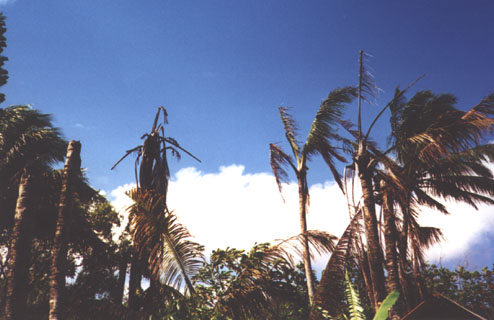Rotten at the Core pg.2
 Although no one really knows how this fungus got to Hawai`i, most scientists believe that it is spread by strong windblown rains, through insects, birds, and mice, or by pruning and planting infected trees. The infection is carried by a given agent (rain, insects, etc.) to the top of a nearby healthy tree where the fungus then moves down into the heart of the palm, producing a rot that slowly destroys the growing shoot and kills the plant.
Although no one really knows how this fungus got to Hawai`i, most scientists believe that it is spread by strong windblown rains, through insects, birds, and mice, or by pruning and planting infected trees. The infection is carried by a given agent (rain, insects, etc.) to the top of a nearby healthy tree where the fungus then moves down into the heart of the palm, producing a rot that slowly destroys the growing shoot and kills the plant.
The first visible symptom of coconut heart rot is the death of the young center leaf, which turns brown and falls over. As the rot advances, other remaining fronds slowly droop and die. Eventually, the top of the tree falls off… leaving what looks like an abandoned pole. Another possible symptom is the appearance of a stem end rot on young developing nuts, which causes them to fall prematurely. The dreadful thing about this disease is that once external symptoms are displayed, the heart of the palm is already rotten and the tree can no longer be saved. Furthermore, if the infected tree is not immediately removed and properly disposed, the fungus can easily spread to neighboring palms.
As precaution, experts recommend the following: never prune healthy trees if you suspect your tools (pruners, knives, etc.), equipment (chain saws, ladders or lifts, truck beds, etc.), or any other materials (hands, gloves, shoes, clothing, etc.) may have been contaminated with the fungus. Thoroughly wash, clean, or disinfect these items with a 20% solution of Clorox, or 70% Isopropyl rubbing alcohol to avoid spreading the disease. Once a dead tree has been cut down, it should be immediately buried, burned (fire permit may be required), or taken to the landfill. When hauling a diseased tree, it must be properly wrapped or covered to prevent any infected tissues or insects from spreading along the roadway, thereby causing new outbreaks in other locations.
